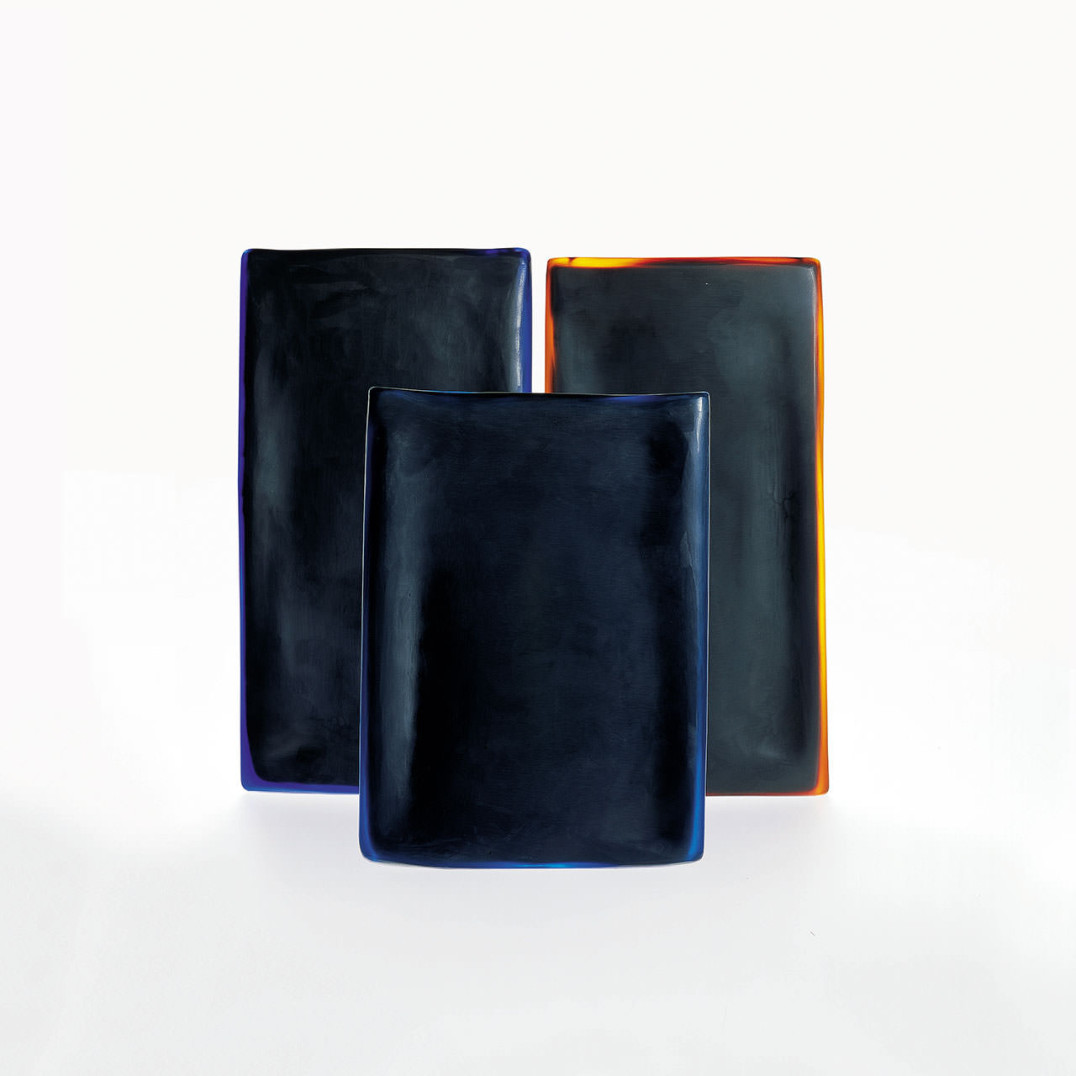
Laura Diaz de SantillanaMetamorfosi, 1999

Laura Diaz de SantillanaMetamorfosi
Three black glass rectangular sculptures. The ones in the left and center have a turquoise blue edge, the one on the right amber.
Engraved: LAURA DE SANTILLANA 1999.
17 1/8 in. high x 9 1/4 in. x 1 1/2 in. (43.5 x 23.5 x 3.8 cm)
12 7/16 in. high x 8 7/8 in. x 1 1/2 in. (31.5 x 22.5 x 3.8 cm)
16 3/4 in. high x 8 7/8 in. x 1 1/2 in. (42.5 x 22.5 x 3.8 cm)
Bibliography and comparative texts:
R. Linzeler, 1922, p. 666;
C. Carrà , 1923, p. 67;
R. Linzeler, 1923, p. 83;
R. Papini, 1930, n. 570;
G. Mariacher, 1967, p. 98;
R. Barovier Mentasti, 1982, n. 252;
Mille anni…, 1982, n. 503;
F. Deboni, 1984, p. n. 70;
W. Neuwirth, 1987, nn. 7, 104;
A. Dorigato, 1986,
p. 71;
F. Deboni, 1989, n. 1;
L’arte del vetro, 1982, n. 307;
M. Heiremans, 1993, n. 191;
M. Barovier, R. Barovier Mentasti,
A. Dorigato, 1995, n. 15;
A. Venini Diaz de Santillana, 1996, n. 1;
R. Barovier Mentasti, 1998, n. 25;
A. Venini Diaz de Santillana, 2000, n. 1;
Olnick Spanu, 2000, n. 8;
Olnick Spanu, 2001, n. 13.
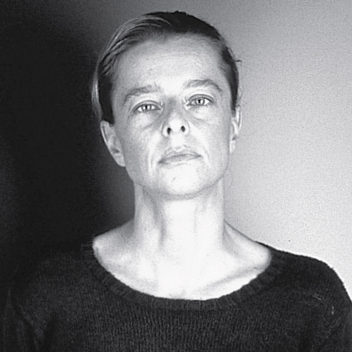
Laura Diaz de Santillana 1955–
Born in Venice, Laura Diaz de Santillana attended the School of Visual Arts in New York. After working as a graphic designer at the design firm of Vignelli Associates in 1976, she returned to Italy and began an active collaboration with Vetreria Venini & C., founded by her grandfather, Paolo Venini. At the workshop, managed with a spirit of great openness by her father, Ludovico Diaz de Santillana, her work brought her in close contact with the many Italian and foreign artists who came to the furnace in those years. During that period, she used the techniques of Murano to create refined works with unusual colors, among which the plates in vetro mosaico deserve particular mention. From 1985 to 1993, she was the designer and artistic director of Eos and later worked as designer for Rosenthal and for Ivan Baj. Further developing her own artistic identity through the creation of original works, lately she has focused her attention on the sculptural qualities of the material, which is often finished in singular textures. De Santillana's meditated study of color has produced original solutions. She has participated in numerous exhibitions in Europe, the United States, and Japan, winning widespread consensus. Several of her works have been acquired by public and private collections such as the Corning Museum of Glass, the Museum für Kunst und Gewerbe in Hamburg, and the Museo Vetrario di Murano.
Laura Diaz de SantillanaMetamorfosi, 1999
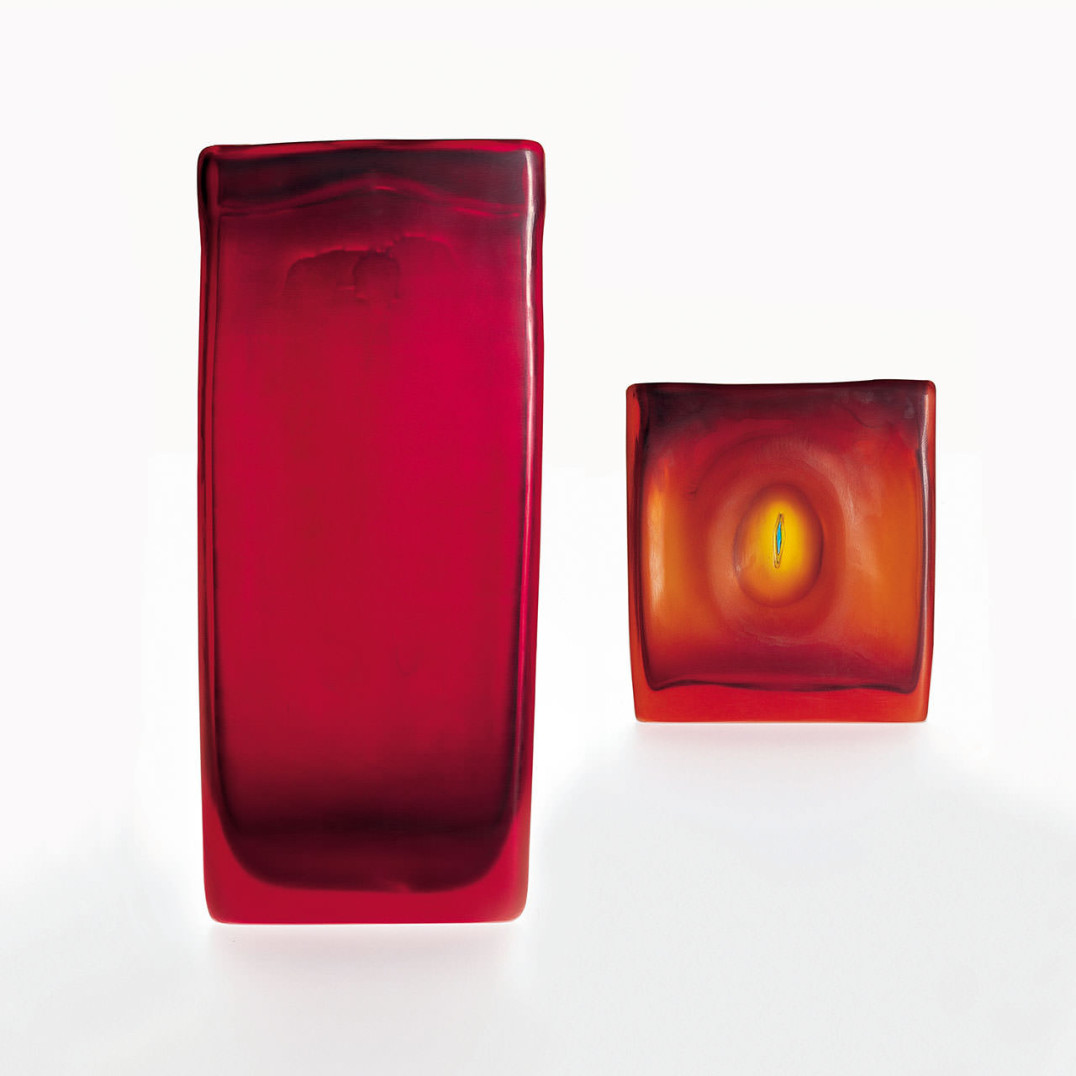
Laura Diaz de SantillanaT15, T5 L'occhio, 1999
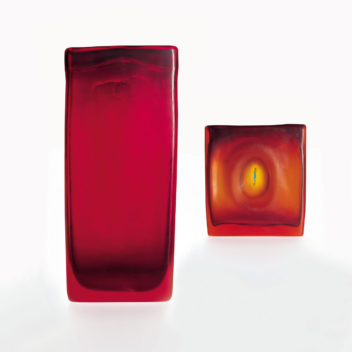
Laura Diaz de SantillanaT15, T5 L'occhio
A sculpture composed of translucent red glass.
Engraved: Laura de Santillana.
20 in. high x 8 15/16 in. x 1 5/8 in. (50.8 x 22.7 x 4.2 cm)
Sculpture in opaque amber glass. The occhio, eye in the center is in transparent turquoise glass.
Engraved: Laura de Santillana.
Bibliography and comparative texts:
R. Linzeler, 1922, p. 666;
C. Carrà , 1923, p. 67;
R. Linzeler, 1923, p. 83;
R. Papini, 1930, n. 570;
G. Mariacher, 1967, p. 98;
R. Barovier Mentasti, 1982, n. 252;
Mille anni…, 1982, n. 503;
F. Deboni, 1984, p. n. 70;
W. Neuwirth, 1987, nn. 7, 104;
A. Dorigato, 1986,
p. 71;
F. Deboni, 1989, n. 1;
L’arte del vetro, 1982, n. 307;
M. Heiremans, 1993, n. 191;
M. Barovier, R. Barovier Mentasti,
A. Dorigato, 1995, n. 15;
A. Venini Diaz de Santillana, 1996, n. 1;
R. Barovier Mentasti, 1998, n. 25;
A. Venini Diaz de Santillana, 2000, n. 1;
Olnick Spanu, 2000, n. 8;
Olnick Spanu, 2001, n. 13.
Glass sculpture in cristallo glass. Each piece blown a canna volante with inclusions of gold leaf. Iridized surface.
Engraved: Patrizia Molinari 2000 or 2001
Each piece
Ø; 7 7/8 in. (20 cm)
6 in. high (15 cm)
Exhibitions:
2001, Rome, Collocazioni Domestiche, S.M.I.T.
2002, Venice, Stanze di Vetro-Glass Rooms, Fondazione Bevilacqua LaMasa
2003, Camerino, Stanze di Vetro-Glass Room, Palazzo Pierbenedetti
2003, London, A Touch of Glass, Italian Cultural Institute
Bibliography and comparative texts:
Barbara Martusciello, Patrizia Molinari S.M.I.T. Rome 2001
Stefano Cecchetto, L’inquietudine dei carichi sospesi-Fragili Esistenze di Riflesso, Stanze di Vetro, Fondazione Bevilacqua La Masa, Venice 2002
Massimo Donà , Dell’arte in trasparenza. Il vetro come metafora di un esistere “eroicamente estetico” Stanze di Vetro Fondazione Bevilacqua La Masa,
Venice 2002
Marco Romanelli, Abitare no. 423 December 2002 issue

Laura Diaz de Santillana 1955–
Born in Venice, Laura Diaz de Santillana attended the School of Visual Arts in New York. After working as a graphic designer at the design firm of Vignelli Associates in 1976, she returned to Italy and began an active collaboration with Vetreria Venini & C., founded by her grandfather, Paolo Venini. At the workshop, managed with a spirit of great openness by her father, Ludovico Diaz de Santillana, her work brought her in close contact with the many Italian and foreign artists who came to the furnace in those years. During that period, she used the techniques of Murano to create refined works with unusual colors, among which the plates in vetro mosaico deserve particular mention. From 1985 to 1993, she was the designer and artistic director of Eos and later worked as designer for Rosenthal and for Ivan Baj. Further developing her own artistic identity through the creation of original works, lately she has focused her attention on the sculptural qualities of the material, which is often finished in singular textures. De Santillana's meditated study of color has produced original solutions. She has participated in numerous exhibitions in Europe, the United States, and Japan, winning widespread consensus. Several of her works have been acquired by public and private collections such as the Corning Museum of Glass, the Museum für Kunst und Gewerbe in Hamburg, and the Museo Vetrario di Murano.
Laura Diaz de SantillanaT15, T5 L'occhio, 1999

Giorgio VignaFuochi d'acqua, 2000
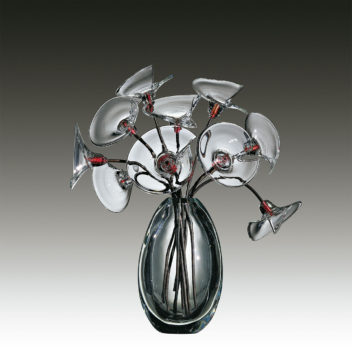
Giorgio VignaFuochi d'acquaVenini S.p.A., 2000
Vase and flowers composed of thick cristallo glass. Stems are made of hollow copper pipes. The red center of the flowers is obtained by the oxidation of the metal when the hot glass is applied.
Engraved: Giorgio Vigna 2002.
28 in. high (71.1 cm)
Bibliography and comparative texts:
R. Linzeler, 1922, p. 666;
C. Carrà , 1923, p. 67;
R. Linzeler, 1923, p. 83;
R. Papini, 1930, n. 570;
G. Mariacher, 1967, p. 98;
R. Barovier Mentasti, 1982, n. 252;
Mille anni…, 1982, n. 503;
F. Deboni, 1984, p. n. 70;
W. Neuwirth, 1987, nn. 7, 104;
A. Dorigato, 1986,
p. 71;
F. Deboni, 1989, n. 1;
L’arte del vetro, 1982, n. 307;
M. Heiremans, 1993, n. 191;
M. Barovier, R. Barovier Mentasti,
A. Dorigato, 1995, n. 15;
A. Venini Diaz de Santillana, 1996, n. 1;
R. Barovier Mentasti, 1998, n. 25;
A. Venini Diaz de Santillana, 2000, n. 1;
Olnick Spanu, 2000, n. 8;
Olnick Spanu, 2001, n. 13.

Giorgio Vigna 1955–
Giorgio Vigna was born in Verona in 1955. He received his artistic training between his hometown, Venice, Rome, and Milan, where he currently lives and works. An artist operating at the boundary between reality and imagination, Vigna explores the line between what is and what appears to be. His works, which span from sculpture to jewelry and from works on paper to site-specific installations, reflect the breadth and depth of his constant research. He uses materials like metal, glass, and paper, exploring with and within them in order to reveal hidden possibilities. The forms he creates express the essence of the elements with which he works: strong and natural, universal and timeless, and full of symbolic meanings. Vigna’s work is permanently exhibited in notable museums and private collections throughout the world, including The State Hermitage Museum, St. Petersburg; Museo di Castelvecchio, Verona; Design Museum, Helsinki; Cooper Hewitt, Smithsonian Design Museum, New York; MAD, Museum of Arts & Design, New York; IMA, Indianapolis Museum of Art, Indianapolis; Honolulu Museum Of Art, Honolulu; Museo degli Argenti, Palazzo Pitti, Florence; MIAAO, Museo Internazionale delle Arti Applicate Oggi, Turin; Civica Raccolta delle Stampe Achille Bertarelli, Castello Sforzesco, Milan; and Olnick Spanu Art Program, Garrison, New York. His most important solo exhibitions include Cosmographies, Galerie Naila de Monbrison, Paris (2015); Sospeso, Elisabetta Cipriani-Jewellery by Contemporary Artists, London (2014); Stati Naturali, Museo di Castelvecchio, Verona (2013; where he created, for the fountain of Carlo Scarpa, the permanent installation in glass, Acquaria); Altrove, Studio Stefania Miscetti, Rome (2011); Altre Nature, Museo Fortuny, Venice (2010); Giorgio Vigna Jewels, Design Museum, Helsinki (2007); Nature di vetro, for VENINI, Museo Correr, Venice (2002). Among his more recent group exhibitions are GLASS Arte del vetro oggi, Villa dei Vescovi - Luvigliano di Torreglia, Padova (2016); ATTRAvetro, Museo Archeologico, Castello Visconteo, Pavia (2015); Gifts from America: 1948-2013. Modern and contemporary applied arts from the Hermitage Museum Foundation (USA), The State Hermitage Museum, St. Petersburg (2014); TRAME, Triennale Design Museum, Milan (2014); Beyond Liaisons, World Jewellery Museum, Seoul (2013); Fragile, Musée Maillol, Paris (2013); Hanging Around: Neckpieces from MAD's Collection, Museum of Arts & Design, New York (2012); TRA. Edge of Becoming, Museo Fortuny, Venice (2011); and Buon Domani\A Better Tomorrow, Studio Stefania Miscetti, Rome (2010).

Venini S.p.A. 2001–
Since 2001 Venini S.p.A. is part of Italian Luxury Industries Group and is led by Giancarlo Chimento, Giuliano Tabacchi and Giorgio Rizzo.